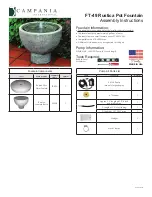
A solid foundation is necessary to prevent settling and tilting of each project. We recommend using a
leveling pad, unless local building code requires you to pour a concrete foundation or build another type
of foundation.
FOUNDATION:
• Choose the location for the completed project; place and mark the position of the base layer of blocks.
Once marked, remove the blocks and the organic top soil within the marked area.
• If applicable to your area, create a leveling pad with a non-frost susceptible, well graded, compacted
angular gravel-sand mixture with fines (GW as per ASTM D248). The leveling pad should be a minimum
of 4 to 6 inches thick. For leveling pads greater than 8” thick, the fill material shall be placed in more
than one lift. Each layer or lift of fill material shall be leveled and compacted to a 95% Standard Proctor
density before moving on.
• Once the top layer of fill material is compacted and level, place the base layer of blocks. The base layer
should sit 1 to 2 inches below grade to help further prevent shifting. Use additional fill material to level
the base layer as needed.
* If a concrete slab is required, prepare a leveling pad using the procedures listed in the paragraphs above. The concrete
shall have a minimum compressive strength of 2500 psi. A 4-inch thick concrete slab should be more than sufficient.
A thickened edge and reinforcement of the leveling slabs may be required. Please consult a professional engineer for
specific requirements.
TIPS FOR BUILDING LEVELING PADS:
3
PREPARE
These plans will walk you through each step as you Prepare, Assemble and Enjoy the new addition to your
yard. Check out the Progress Bar at the bottom of each page to track your advancements as you complete
each phase of your project!
INSTRUCTIONS:
• Please research and follow
local building codes prior to
the excavation, construction
and assembly of your
project.
• Exercise caution when
you work with Concrete
Block designs. Wear
protective safety
equipment such as safety
glasses, dust masks,
gloves and a hard hat.
• Whether you plan to
build the project yourself
or to hire a professional,
every project requires a
call to mark your utility
lines.
BEFORE YOU BEGIN:
It is the responsibility of the owner to ensure compliance with all applicable laws, codes and regulations
for any project. Proper safety precautions must be taken prior to and during the construction of each
project. Please follow standard safety guidelines and wear necessary protective equipment when building
and using your new backyard addition.
RESPONSIBILITIES:
Rubber Mallet
Level
Utility Knife
Caulk Gun
Protective Equipment
Tape Measure
TOOL CHECK LIST
Chisel
Standard Hammer



























